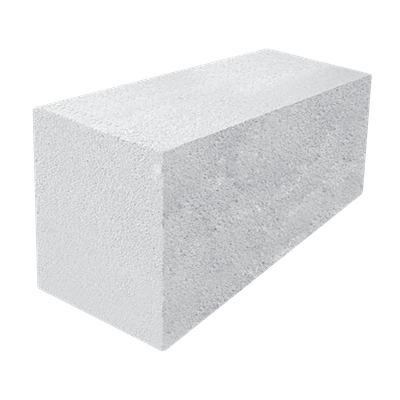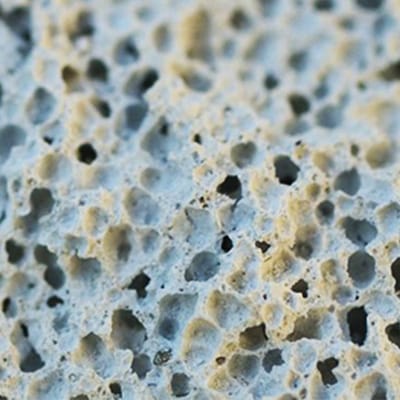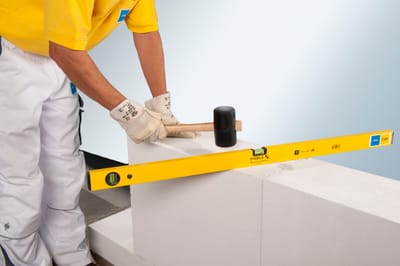AAC BLOCK



Autoclaved Aerated Concrete (AAC) Block
Autoclaved Aerated Concrete is a Lightweight, Load-bearing, High-insulating, Durable building product, which is produced in a wide range of sizes and strengths. AAC Blocks is lightweight and compare to the red bricks AAC blocks are three times lighter.
The Autoclaved Aerated Concrete (AAC) material was developed in 1924 in Sweden. It has become one of the most used building materials in Europe and is rapidly growing in many other countries around the world. AAC is produced from the common materials lime, sand, cement and water, and a small amount of rising agent. After mixing and molding, it is then autoclaved under heat and pressure to create its unique properties. AAC has excellent thermal insulation and acoustic absorption properties. AAC is fire and pest resistant, and is economically and environmentally superior to the more traditional structural building materials such as concrete, wood, brick and stone.
At the point when AAC is blended and cast in structures, a few compound responses occur that give AAC its light weight (20% of the heaviness of cement) and warm properties. Aluminum powder responds with calcium hydroxide and water to frame hydrogen. The hydrogen gas froths and copies the volume of the crude blend making gas rises to 3 mm (⅛ inch) in distance across. Toward the end of the frothing procedure, the hydrogen escapes into the air and is supplanted via air. AAC Blocks is a unique and excellent type of building material due to its super heat, fire and sound resistance, AAC blocks are lightweight and offers ultimate work-ability, flexibility and durability. Its main ingredients include sand, water, quicklime, cement and gypsum. The chemical reaction due to the aluminum paste provides AAC its distinct porous structure, lightness, and insulation properties, completely different compared to other lightweight concrete materials. When the forms are removed from the material, it is solid but still soft. It is then cut into either blocks or panels, and placed in an autoclave chamber for 12 hours. During this steam pressure hardening process, when the temperature reaches 190° Celsius (374° Fahrenheit) and the pressure reaches 8 to 12 bars, quartz sand reacts with calcium hydroxide to form calcium silicate hydrate, which gives AAC its high strength and other unique properties. Because of the relatively low temperature used AAC blocks are not considered fired brick but a lightweight concrete masonry unit. After the autoclaving process, the material is ready for immediate use on the construction site. Depending on its density, up to 80% of the volume of an AAC block is air. AAC's low density also accounts for its low structural compression strength. It can carry loads of up to 8 MPa (1,160 PSI), approximately 50% of the compressive strength of regular concrete.
AAC offers incredible opportunities to increase building quality and at the same time reduce costs at the construction site.
AAC is produced out of a mix of quartz sand and/or pulverized fly ash (PFA), lime, cement, gypsum, water and aluminum and is hardened by steam-curing in autoclaves. As a result of its excellent properties, AAC is used in many building constructions, for example in residential homes, commercial and industrial buildings, schools, hospitals, hotels and many other applications. AAC contains 60% to 85% air by volume.
Autoclaved Aerated Concrete is a Lightweight, Load-bearing, High-insulating, Durable building product, which is produced in a wide range of sizes and strengths. AAC Blocks is lightweight and compare to the red bricks AAC blocks are three times lighter.
The Autoclaved Aerated Concrete (AAC) material was developed in 1924 in Sweden. It has become one of the most used building materials in Europe and is rapidly growing in many other countries around the world. AAC is produced from the common materials lime, sand, cement and water, and a small amount of rising agent. After mixing and molding, it is then autoclaved under heat and pressure to create its unique properties. AAC has excellent thermal insulation and acoustic absorption properties. AAC is fire and pest resistant, and is economically and environmentally superior to the more traditional structural building materials such as concrete, wood, brick and stone.
At the point when AAC is blended and cast in structures, a few compound responses occur that give AAC its light weight (20% of the heaviness of cement) and warm properties. Aluminum powder responds with calcium hydroxide and water to frame hydrogen. The hydrogen gas froths and copies the volume of the crude blend making gas rises to 3 mm (⅛ inch) in distance across. Toward the end of the frothing procedure, the hydrogen escapes into the air and is supplanted via air. AAC Blocks is a unique and excellent type of building material due to its super heat, fire and sound resistance, AAC blocks are lightweight and offers ultimate work-ability, flexibility and durability. Its main ingredients include sand, water, quicklime, cement and gypsum. The chemical reaction due to the aluminum paste provides AAC its distinct porous structure, lightness, and insulation properties, completely different compared to other lightweight concrete materials. When the forms are removed from the material, it is solid but still soft. It is then cut into either blocks or panels, and placed in an autoclave chamber for 12 hours. During this steam pressure hardening process, when the temperature reaches 190° Celsius (374° Fahrenheit) and the pressure reaches 8 to 12 bars, quartz sand reacts with calcium hydroxide to form calcium silicate hydrate, which gives AAC its high strength and other unique properties. Because of the relatively low temperature used AAC blocks are not considered fired brick but a lightweight concrete masonry unit. After the autoclaving process, the material is ready for immediate use on the construction site. Depending on its density, up to 80% of the volume of an AAC block is air. AAC's low density also accounts for its low structural compression strength. It can carry loads of up to 8 MPa (1,160 PSI), approximately 50% of the compressive strength of regular concrete.
AAC offers incredible opportunities to increase building quality and at the same time reduce costs at the construction site.
AAC is produced out of a mix of quartz sand and/or pulverized fly ash (PFA), lime, cement, gypsum, water and aluminum and is hardened by steam-curing in autoclaves. As a result of its excellent properties, AAC is used in many building constructions, for example in residential homes, commercial and industrial buildings, schools, hospitals, hotels and many other applications. AAC contains 60% to 85% air by volume.

